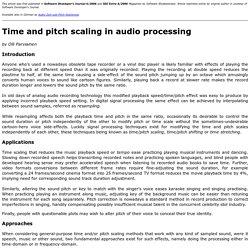

Properties of Sound Waves Lesson Loudness Pitch and Quality. Justin Boyd: Sound and Time. Article. This article was first published in Software Developer's Journal 4/2006 and SDJ Extra 4/2006 Magazines by Software Wydawnictwo.

Article reprinted online by original author in courtesy of Software Developer's Journal. Available also in German as Audio-Zeit-und-Pitch-Skalierung. by Olli Parviainen Introduction Anyone who's used a nowadays obsolete tape recorder or a vinyl disc player is likely familiar with effects of playing the recording back at different speed than it was originally recorded: Playing the recording at double speed reduces the playtime to half, at the same time causing a side-effect of the sound pitch jumping up by an octave which amusingly converts human voices to sound like cartoon figures. In old days of analog audio recording technology this modified playback speed/time/pitch effect was easy to produce by applying incorrect playback speed setting. Applications. Schubin Cafe » All-Mobile Video. Implicit 3D eyewear range at NAB 2010 As I roamed the exhibits at the NAB show this month, I kept wondering what other year it seemed most like.

And I was not alone. There were plenty of important issues covered at the show, from citizen journalism to internet-connected TV. And then there was the elephant in the room. Audio time-scale/pitch modification - Wikipedia. These processes are used, for instance, to match the pitches and tempos of two pre-recorded clips for mixing when the clips cannot be reperformed or resampled.

(A drum track containing no pitched instruments could be moderately resampled for tempo without adverse effects, but a pitched track could not). They are also used to create effects such as increasing the range of an instrument (like pitch shifting a guitar down an octave). Resampling[edit] Sound Localization. Complex systems. Complex systems present problems both in mathematical modelling and philosophical foundations.

The study of complex systems represents a new approach to science that investigates how relationships between parts give rise to the collective behaviors of a system and how the system interacts and forms relationships with its environment.[1] Such systems are used to model processes in computer science, biology,[2] economics, physics, chemistry,[3] and many other fields. It is also called complex systems theory, complexity science, study of complex systems, sciences of complexity, non-equilibrium physics, and historical physics. A variety of abstract theoretical complex systems is studied as a field of mathematics. The key problems of complex systems are difficulties with their formal modelling and simulation.
Overview[edit] History[edit] Self-organization. Self-organization occurs in a variety of physical, chemical, biological, robotic, social and cognitive systems.

Common examples include crystallization, the emergence of convection patterns in a liquid heated from below, chemical oscillators, swarming in groups of animals, and the way neural networks learn to recognize complex patterns. Overview[edit] Complex Adaptive Systems: 9 Cellular Automaton + Related Videos - Mashpedia. In this video we are going to discuss cellular automata, we will firstly talk about what they are before looking at a classical example, we will then discuss individually the different classes of patterns that cellular automata can generate before wrapping-up with a talk about their significance as a new approach to mathematical modeling.

For full courses, transcriptions & downloads please see: Twitter: Facebook: Transcription Excerpt: Cellular automata are algorithmic models that use computation to iterate on very simple rules, in so doing these very simple rules can create complex emergent phenomena through the interaction between agents as they evolve over time. To illustrate the functioning of a cellular automaton we will take an example from probably the most famous algorithm called the Game Of Life devised by the mathematician John Conway. "THE GEOMETRY OF MUSIC, ART AND STRUCTURE ...linking Science, Art and Esthetics" copyright 2009-12, Reginald Brooks.
Copyright© 2009, Reginald Brooks.

All rights reserved That simple geometric principles can be responsible for the manifestation of the multitudes of beauty, diversity and richness of Nature is further supported here in this paper. The Inverse-Square-Law (ISL), a simple geometric principle, is shown to be the common link between physics, chemistry, biology, and the science and esthetics of music and art. Nature has incorporated the ISL as the major game rule to building the cosmos. The Anatomy of a Curved Mirror. Thus far in this unit, our focus has been the reflection of light off flat surfaces and the formation of images by plane mirrors.

In Lessons 3 and 4 we will turn our attention to the topic of curved. Reflection and refraction. EXACT NUMBERS. Certain types of numbers are considered “exact.”

For example, there are exactly 16 ounces in one pound. The number 16 would have as many significant figures as needed. So one pound has 16.000000000000.... ounces. Calculations involving this number should not be limited by the significant figures shown in “16 oz/lb.” Closed system. Www.algarcia.org/AnimationPhysics/BalanceTutorial.pdf. Untitled. Fundamental domain. There are many ways to choose a fundamental domain.

Typically, a fundamental domain is required to be a connected subset with some restrictions on its boundary, for example, smooth or polyhedral. The images of a chosen fundamental domain under the group action then tile the space. One general construction of fundamental domains uses Voronoi cells. Hints at general definition[edit] Discrete vs Continuous Symmetry. Fractal Geometry. Continuous symmetry. Formalization[edit] IGCSE Physics Challenging Drill Questions (Yellowreef) - Thomas Bond, Chris Hughes. Charge (physics) , where H is the Hamiltonian. Physical Definition of Time. From the age of Newton up until Einstein's profound reinterpretation of the physical concepts associated with time and space, time was considered to be "absolute" and to flow "equably" (to use the words of Newton) for all observers. The science of classical mechanics is based on this Newtonian idea of time. Einstein, in his special theory of relativity, postulated the constancy and finiteness of the speed of light for all observers.
He showed that this postulate, together with a reasonable definition for what it means for two events to be simultaneous, requires that distances appear compressed and time intervals appear lengthened for events associated with objects in motion relative to an inertial observer. Classical mechanics. Can brain waves interfere with radio waves? Radio waves and brain waves are both forms of electromagnetic radiation—waves of energy that travel at the speed of light. The difference between brain waves, radio waves, and other electromagnetic waves (such as visible light, X-rays and Gamma rays) lies in their frequency—that is, how often the waves peak and trough in a second.
Radio waves, which include radio and other wireless transmission signals, as well as other natural signals in the same frequency, peak and trough at between 50 and 1000 megahertz—that’s between 50 million and one billion oscillations per second. The human brain also emits waves, like when a person focuses her attention or remembers something. This activity fires thousands of neurons simultaneously at the same frequency generating a wave—but at a rate closer to 10 to 100 cycles per second. Universe of Light: What is the Amplitude of a Wave?
Spectrum. Oscillatory timing. Amplitude.